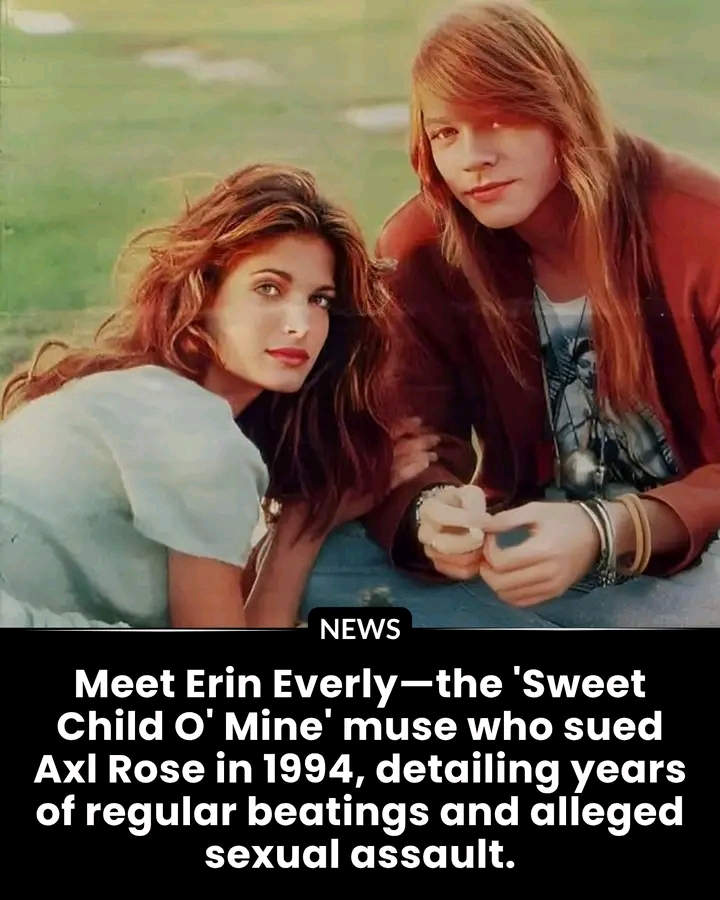
When Axl Rose sang “She’s got a smile that it seems to me…” in 1987, the world melted. That smile innocent, haunting, unforgettable belonged to Erin Everly, the woman who inspired Guns N’ Roses’ most iconic ballad, “Sweet Child O’ Mine.” To millions, she was the face behind the song that defined a generation. To Rose, she was the love of his life or so it seemed. But behind the romance that powered one of rock’s greatest anthems lay a dark, painful reality that few fans ever knew.
Erin Everly’s story began like a fairytale soaked in rock and roll. The daughter of Don Everly of the Everly Brothers, music was literally in her blood. She grew up surrounded by the legends of the ’60s, and by the mid-1980s, she was navigating the wild Los Angeles scene that birthed some of the greatest bands of all time. It was there, at a party in 1986, that she met a young, volatile singer named Axl Rose.
He was dangerous, magnetic, unpredictable the kind of man who made every room hum when he entered it. Erin was shy, sensitive, and luminous, the calm eye in his storm. Their connection was instant, but it was also combustible. “They couldn’t be apart,” one former acquaintance once recalled, “but they couldn’t be together either without something breaking.”
When “Sweet Child O’ Mine” hit the airwaves in 1988, it catapulted both Axl and Erin into myth. The video featured her subtly, and Rose’s obsession with her was written into every lyric. He described her as “the only person who ever really saw me.” For fans, they were rock’s ultimate love story the dangerous frontman and his angelic muse. But fame has a cruel way of blurring what’s real and what’s performance.
Behind closed doors, that love story became a nightmare.
By the early 1990s, their relationship had spiraled into chaos. Those who were close to them described endless fights, emotional manipulation, and moments of violence that hinted at something much darker. In 1990, they married impulsively in Las Vegas after a night of arguing and making up a pattern that defined their entire relationship. The marriage lasted less than a year.
Four years later, in 1994, Erin Everly filed a civil lawsuit against Axl Rose. The documents alleged that she endured years of physical and emotional abuse, including beatings and sexual battery. According to her claims, Rose’s temper would explode without warning, and she lived in a constant state of fear. The case was quietly settled out of court, the details sealed—but the story left a permanent mark on how the world viewed one of rock’s most mythologized figures.
And then, Erin Everly disappeared.
Not in a tabloid sense not running from paparazzi or making talk show rounds but truly vanished from the public eye. While Axl continued to court controversy, release records, and reinvent his legend, Erin chose the opposite path. She retreated from fame, from interviews, from all the noise. She stopped being the muse and started being a survivor.
Those who have caught glimpses of her in later years describe a woman who rebuilt her life brick by brick, choosing peace over publicity. She became a mother, focused on her family, and found quiet work far from Hollywood. Her resilience became her rebellion. In an era when victims were often dismissed or mocked, she never sought headlines or revenge. She simply lived.
That silence measured, powerful, and deliberate has made her story resonate even louder over time. In recent years, as the world has reevaluated how women in the entertainment industry were treated in the past, Erin’s story has reemerged as a cautionary tale of how fame, power, and youth collided in the most toxic ways during rock’s excess-fueled era.
For every romanticized ballad about a muse, there’s often an untold story of what happens when the music stops. Erin’s quiet exit from that world wasn’t just an escape it was a declaration that her worth was never defined by being someone’s inspiration.
Fans still hear her ghost in “Sweet Child O’ Mine.” That smile, that light, the tenderness that made the song immortal it all came from a real place. But knowing what came next changes how we hear it. It becomes not just a love song, but a time capsule—a moment of purity trapped before the storm broke.
Axl Rose, in later years, has been more reflective, often hinting at regrets and pain from his past. But Erin has never publicly spoken in detail about her life after him. That choice—to stay private, to heal without spectacle—might be the most radical act of all in a culture obsessed with oversharing.
In her absence, she’s become something more than a footnote in rock history. She’s become a symbol of endurance. Of what it means to survive love when love turns violent. Of the strength it takes to walk away, not with revenge, but with grace.
Every time “Sweet Child O’ Mine” plays, millions of listeners hum along to the melody of devotion—but the real story beneath it belongs to a woman who endured, healed, and lived on her own terms. Erin Everly may have inspired one of the greatest love songs in rock history, but her true legacy lies in what came after: the courage to rebuild herself when the world wasn’t watching.
Today, she remains a mystery—by choice. And that mystery, that quiet dignity, might be her greatest revenge.
In the end, Erin Everly’s story reminds us that behind every song, every legend, there’s a human being with scars and strength. She’s no longer the “sweet child” frozen in the lyrics of a rock ballad. She’s a woman who faced the fire and found peace in her own silence. And maybe, just maybe, that’s the most powe
rful verse of all.

Leave a Reply